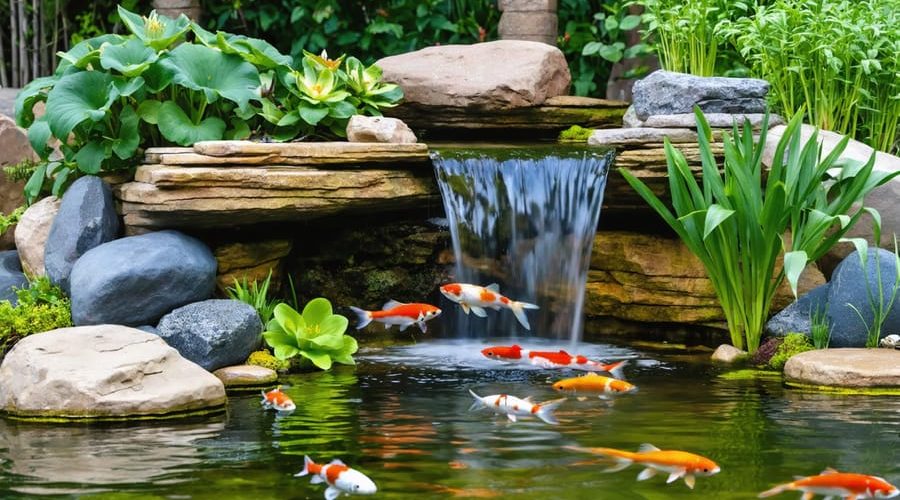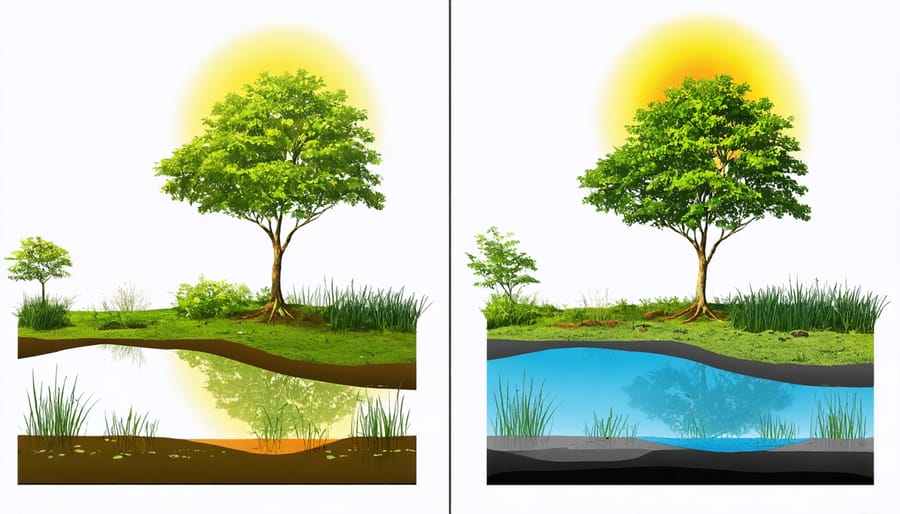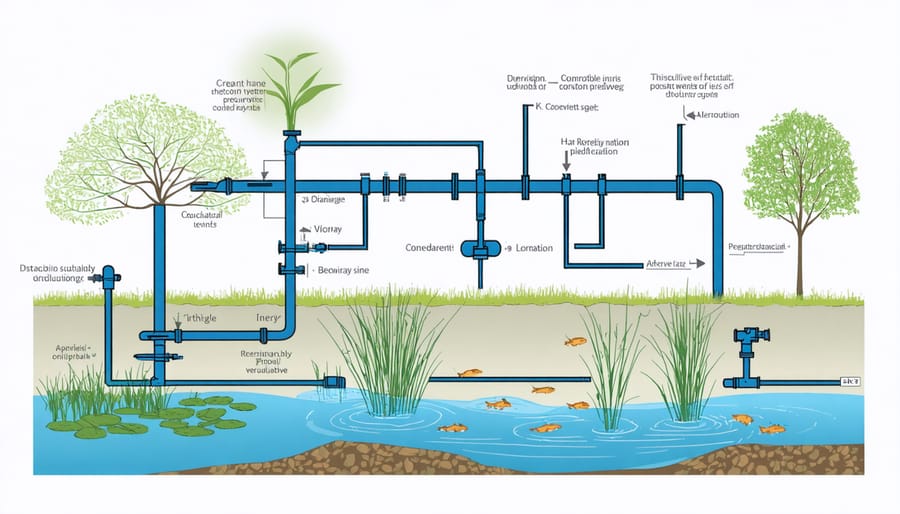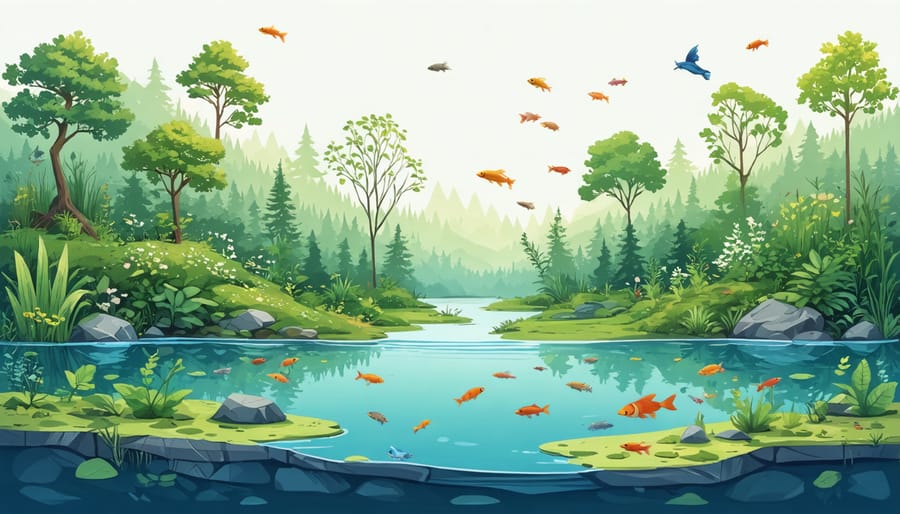
Create Your Dream Pond Ecosystem in Just One Weekend
Transform your backyard into a thriving balanced aquatic ecosystem by creating a self-sustaining pond that mirrors nature’s perfect design. Start by selecting a partially shaded location away from falling leaves and runoff, ensuring at least six hours of daily sunlight for optimal plant growth. Excavate your pond with varying depths – shallow margins (4-8 inches) for marginal plants, mid-depth shelves (12-18 inches) for aquatic plants, and a deeper central area (24-36 inches) for fish and temperature stability. Layer high-quality EPDM rubber liner over protective underlay, incorporating natural filtration zones with gravel and beneficial bacteria to establish biological balance. Create habitat diversity using native aquatic plants, submerged oxygenators, and strategic rock placement, setting the foundation for a vibrant micro-ecosystem that will attract wildlife and maintain itself naturally over time.
Planning Your Perfect Pond Location
Sunlight and Shade Balance
Finding the right balance between sunlight and shade is crucial for a healthy pond ecosystem. Your pond needs optimal sunlight conditions to support plant growth while preventing excessive algae bloom. Aim for 4-6 hours of direct sunlight daily, preferably during morning hours.
To assess your location’s sun exposure, observe the area throughout the day and mark sunny spots on a simple sketch of your yard. Consider seasonal changes – areas that are sunny in winter might become too shaded in summer when trees are fully leafed. Avoid placing your pond directly under trees to prevent falling leaves from decomposing in the water.
If your yard offers multiple location options, choose a spot that provides partial shade during the hottest part of the day. This natural protection helps maintain stable water temperatures and reduces water loss through evaporation. You can also create artificial shade using attractive features like pergolas or strategically placed water plants, which add both functionality and visual appeal to your pond ecosystem.
Remember, different pond plants have varying light requirements, so understanding your location’s sun patterns helps you select the right mix of aquatic vegetation for your specific situation.

Ground Analysis and Utilities
Before breaking ground on your pond project, it’s crucial to analyze your soil conditions and identify any underground utilities. Start by contacting your local utility companies or calling 811 (in the United States) to have them mark underground lines. This free service helps you avoid potentially dangerous and costly accidents during excavation.
Next, assess your soil type by performing a simple percolation test. Dig a hole about 2 feet deep and fill it with water. If the water drains within 24 hours, you have well-draining soil. If it takes longer, you might need additional liner protection or drainage solutions. Clay soil can be beneficial as it naturally holds water, but sandy soil might require extra reinforcement.
Look for natural slopes in your yard and consider how water naturally flows through your property. This information will help you position your pond correctly and prevent flooding issues. Also, check local building codes and obtain necessary permits before starting your excavation. Some areas have specific requirements regarding pond depth, distance from property lines, and safety features.
Essential Components of a Healthy Pond
Filtration Systems
A well-functioning pond filtration systems is the heart of a healthy pond ecosystem. There are three main types of filters you’ll need to consider: mechanical, biological, and chemical filters.
Mechanical filters are your first line of defense, catching larger debris like leaves, twigs, and other particles before they can decompose in your pond. Think of them as a kitchen strainer for your pond water. These typically include skimmers and settling chambers that trap floating debris.
Biological filters are where the magic happens! They house beneficial bacteria that break down harmful waste products like ammonia and nitrites into less harmful substances. These can be pressure filters, waterfall boxes, or even specialized areas in your pond with lots of surface area for bacteria to colonize.
Chemical filters, while not always necessary, can help polish your water and remove specific contaminants. Activated carbon is commonly used to remove discoloration and odors, while zeolite helps control ammonia levels.
For small ponds under 1,000 gallons, an all-in-one filter system might be sufficient. Larger ponds usually benefit from a combination of different filter types working together. Remember to size your filtration based on your pond volume, fish load, and plant quantity. Regular maintenance of your filters is crucial – I usually recommend checking them every few weeks during peak season.

Circulation and Aeration
Just like our own bodies need oxygen, a pond ecosystem relies on proper circulation and aeration to thrive. Moving water isn’t just pleasing to the eye – it’s essential for maintaining healthy oxygen levels that support fish, plants, and beneficial bacteria.
A good circulation system keeps water moving throughout your pond, preventing stagnant areas where algae can bloom and debris can accumulate. Think of it as your pond’s circulatory system, constantly moving nutrients and oxygen to where they’re needed most. Install a pump that turns over your pond’s entire volume at least once every two hours for optimal results.
Aeration is equally important, especially in warmer months when oxygen levels naturally decrease. You can add oxygen to your pond through various methods: waterfalls, fountain features, or air pumps with diffusers. For smaller ponds, a simple fountain can provide both beautiful aesthetics and sufficient aeration. Larger ponds might benefit from bottom diffusers, which release tiny bubbles that rise through the water column, maximizing oxygen distribution.
During summer, consider running your aeration system 24/7. In winter, reduce aeration near the surface to prevent excessive cooling, but maintain some bottom aeration to help decompose organic matter and provide fish with oxygen-rich zones.
Remember, you can often tell if your pond needs more aeration by watching your fish – if they’re frequently gulping at the surface, it’s time to boost your oxygen levels.
Building Your Living Ecosystem

Aquatic Plants Selection
A successful pond ecosystem relies heavily on proper aquatic plant selection and positioning. Aim to include plants from four main categories to create a balanced environment. Start with oxygenating plants like Hornwort or Elodea, which help maintain water quality by producing oxygen and absorbing excess nutrients. These should cover about 60% of your pond’s surface area.
Next, add floating plants such as Water Lilies or Water Hyacinth to provide shade and surface coverage. These help control algae growth by limiting sunlight penetration and offer shelter for pond inhabitants. Include marginal plants like Marsh Marigold or Japanese Rush around the pond’s edges, planting them in shallow shelves or baskets. These plants create a natural transition between water and land while providing essential hiding spots for wildlife.
Don’t forget about submerged plants like Anacharis or Vallisneria, which offer additional oxygenation and create underwater forests where fish can hide and breed. Position these plants at various depths, ensuring larger specimens are placed toward the back of the pond and shorter varieties in the front for a pleasing visual effect.
Remember to avoid overcrowding – leave enough open water for fish movement and surface reflection. Start with a few plants from each category and add more as needed, allowing your pond ecosystem to develop naturally over time.
Fish Species Selection
Choosing the right fish species is crucial for a balanced pond ecosystem. Start with hardy fish that can adapt well to pond life, such as goldfish and koi. These popular choices are not only beautiful but also help maintain the ecosystem by eating algae and mosquito larvae.
For smaller ponds (under 1,000 gallons), stick to goldfish varieties like Common, Shubunkin, or Comets. These fish are resilient and don’t grow as large as koi. In larger ponds, you can introduce koi, which add stunning colors but require more space and maintenance.
Consider including bottom feeders like weather loaches or catfish to help keep the pond floor clean. Native minnows or golden tench are excellent choices for natural pest control and add movement to your pond.
When stocking, follow the general rule of 1 inch of fish per 10 gallons of water. Start with fewer fish than your pond’s maximum capacity – it’s easier to add more later than to deal with overcrowding. Introduce fish gradually, allowing the ecosystem to stabilize between additions.
Remember to quarantine new fish for at least two weeks before adding them to your pond. This helps prevent the introduction of diseases and allows you to monitor their health. Always purchase fish from reputable suppliers who can provide information about their origin and care requirements.
Beneficial Microorganisms
Just like a city needs its sanitation workers, your pond needs beneficial microorganisms to keep it healthy and clean. These tiny heroes break down waste, balance nutrients, and create a thriving ecosystem for your aquatic plants and fish.
To jumpstart your pond’s microorganism population, consider adding beneficial bacteria products specifically designed for ponds. These come in liquid or powder form and contain various strains of helpful bacteria that naturally occur in healthy water bodies. The best time to introduce these beneficial microorganisms is during the initial setup and throughout the warmer months when biological activity is highest.
These microscopic helpers work tirelessly to:
– Convert fish waste and dead plant material into nutrients
– Reduce excess ammonia and nitrites
– Clear cloudy water
– Control algae growth by competing for nutrients
– Break down organic sludge at the bottom of your pond
For best results, add beneficial bacteria every few weeks during the growing season. You can also boost their population by including submerged plants and creating areas with rocks and gravel where these beneficial microorganisms can colonize. Remember that chlorinated water can harm these helpful bacteria, so always use a water conditioner when adding fresh water to your pond.
These invisible allies are truly the unsung heroes of your pond ecosystem, working 24/7 to maintain crystal-clear, healthy water for all your pond inhabitants.
Maintaining Balance and Harmony
Seasonal Care Requirements
Your pond ecosystem requires different care throughout the year to maintain its health and beauty. In spring, focus on cleaning out debris that accumulated over winter and checking your pump and filtration systems. Add beneficial bacteria to jumpstart the biological processes, and trim back any dead plant material. This is also the perfect time to introduce new plants and check water quality.
Summer maintenance involves managing algae growth by ensuring proper shade from floating plants and regularly removing any excess growth. Keep water levels consistent during hot weather by topping up when needed, and feed fish moderately as they’re most active during this season.
As autumn approaches, start reducing fish feeding and remove falling leaves before they sink and decay. Install pond netting to catch leaves and protect fish from predators. Cut back dying plant material and remove tropical water plants that won’t survive winter.
Winter care is minimal but crucial. Keep a small area free of ice using a floating deicer to allow gas exchange, especially if you have fish. Don’t break ice directly on the pond surface as this can harm hibernating fish. Stop feeding fish when water temperatures drop below 50°F (10°C), and remove your pump if you live in an area with harsh winters to prevent damage from freezing.
Remember to perform regular water quality tests throughout the year and adjust your care routine based on your specific climate and pond conditions.
Problem Prevention
Creating a pond ecosystem can face several common challenges, but with proper planning and maintenance, you can avoid most issues. One frequent problem is algae overgrowth, which can be prevented by maintaining proper plant coverage (around 60-70% of the water surface) and installing an effective filtration system.
Water quality issues often arise from overfeeding fish or overstocking. Start with fewer fish than you think you need – a good rule of thumb is one inch of fish per 10 gallons of water. Feed them only what they can consume in five minutes, once or twice daily.
Leaks can be devastating but are preventable. During construction, ensure your liner is properly installed with no sharp rocks underneath, and create a generous overlap at the edges. Regular inspection of the liner and maintaining consistent water levels will help you spot potential issues early.
Predator problems can be addressed by incorporating deeper areas (at least 2 feet) for fish to hide, adding floating plants for cover, and installing protective netting if needed. Remember that some natural predation is part of a healthy ecosystem.
Seasonal challenges like freezing can be managed by installing a de-icer in cold climates and maintaining a small opening in the ice for gas exchange. In summer, provide adequate shade to prevent excessive water temperature increases and oxygen depletion.
Creating your own pond ecosystem is an exciting journey that brings nature right to your doorstep. By following the steps we’ve outlined, you can transform a simple water feature into a thriving, self-sustaining environment that delights both you and local wildlife. Remember that success lies in careful planning, proper layering of your pond elements, and selecting the right mix of plants and animals.
Don’t be intimidated by the process – start small if you need to, and expand your ecosystem as you gain confidence. The key is maintaining balance: between sunlight and shade, plants and fish, and beneficial bacteria and nutrients. Regular monitoring and maintenance will help your pond flourish, but nature will do most of the heavy lifting once you’ve set up the right conditions.
Whether you’re creating a meditation spot, a wildlife haven, or a beautiful water garden, your pond ecosystem will become more beautiful and diverse with each passing season. So gather your supplies, make your plan, and take that first step toward creating your own slice of aquatic paradise. The rewards of watching your pond ecosystem come to life are truly worth every effort!
